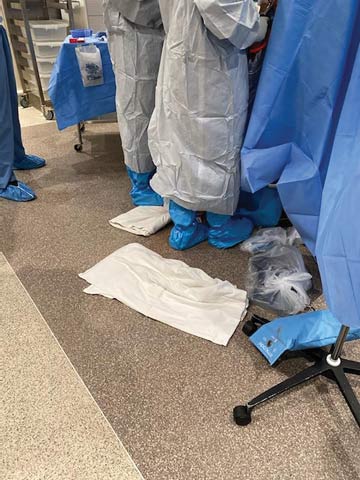Have you ever successfully navigated across multiple rooms of your house in total darkness without so much as grazing into something because you know the overall layout like the back of your hand? With the proper setup, that type of awareness
can (and should) take place in the OR. "Whenever I was circulating, I always tried to set up cases the exact same way," says Amy Brunson, MSN, RN, CNOR, nurse manager at Baylor Scott & White Medical Center in Temple, Texas. "That way,
my team knew exactly where equipment was going to be positioned every time, and staff weren't tripping over something because it was set up a bit differently."
For Ms. Brunson, that setup included strategically positioning all of the equipment at the bottom of the bed with all the cords veering off in the same direction — ideally an area where the staff traffic is going to be limited.
There are several safety benefits to the newer integrated systems, including slip-and-trip protection. "The equipment is all hanging from booms that can be plugged into directly," says Ms. Brunson. "This can limit or even eliminate the cords
that you plug into the wall and have all over your OR floor." On top of the cord reduction, the booms also reduce the equipment you need to bring into the OR, making it easier for staff to move freely during cases, she adds.
Even the most meticulously organized and obstacle-free OR leaves staff vulnerable to slips on slick floors. Whether it's from a generous mopping between cases or an overflow of irrigants or bodily fluids during an arthroscopy case, fluids
are often an issue in the OR. The amount of fluid produced during notoriously sloppy orthopedic cases is highly variable, depending on the procedure or surgeon involved.
"We have some surgeons who irrigate joints with just one liter during knee and shoulder procedures, and another surgeon who uses 30 liters," says Mr. Taylor.
There are a variety of systems that keep floors dry, from mobile units that collect large volumes of runoff directly from the surgical site to floor-based wicking systems, but high-tech can't replace high-touch in this area. Regardless of
whether you're using the latest mobile fluid-collection devices or simply throwing towels or blankets on the floor, a key component of preventing slips in the OR will always center around an alert and team-centered staff.
"Preventing slips is all about awareness," says Mr. Taylor. "It's everyone's job to be aware and look out for each other. If there's irrigation runoff on the floor, someone needs to call that out to ensure everyone is aware before cleaning
it up." Cords stretched across floors in high-traffic areas create tripping hazards, and recent regulatory changes have increased the challenge of cord management in the OR. "New Joint Commission regulations require cords to be plugged
into a wall instead of a power strip or an extension cord," says Ms. Brunson.
That said, there are still plenty of simple and painless ways to keep cords out of your staff's way. Mr. Taylor organizes equipment cords at the heads of the OR beds, where staff know to look out for them, and always tries to position them
away from high-traffic areas. He's also a strong advocate for an inexpensive cure-all. "A nurse's best friend is a roll of tape," he says. "If a cord poses a tripping threat, more often than not we simply tape it down in place."
Ms. Brunson has seen lots of methods used to manage problematic cords, from creative in-house attempts to a variety of commercially made covers that stick to the floor. But, she says, oftentimes something as simple as a durable non-slip mat,
like the kind you'd find in a kitchen, is an extremely effective safeguard against falls. Also, the difference between an uneventful procedure and filling out an incident report can come down to stepping back and exercising some common
sense — even if the move is a minor inconvenience in the short-term. "Sometimes, it's as simple as unplugging the cord from a high-traffic area and plugging it in somewhere where there's no chance of someone tripping over it," says
Ms. Brunson.
.svg?sfvrsn=be606e78_3)

.svg?sfvrsn=56b2f850_5)